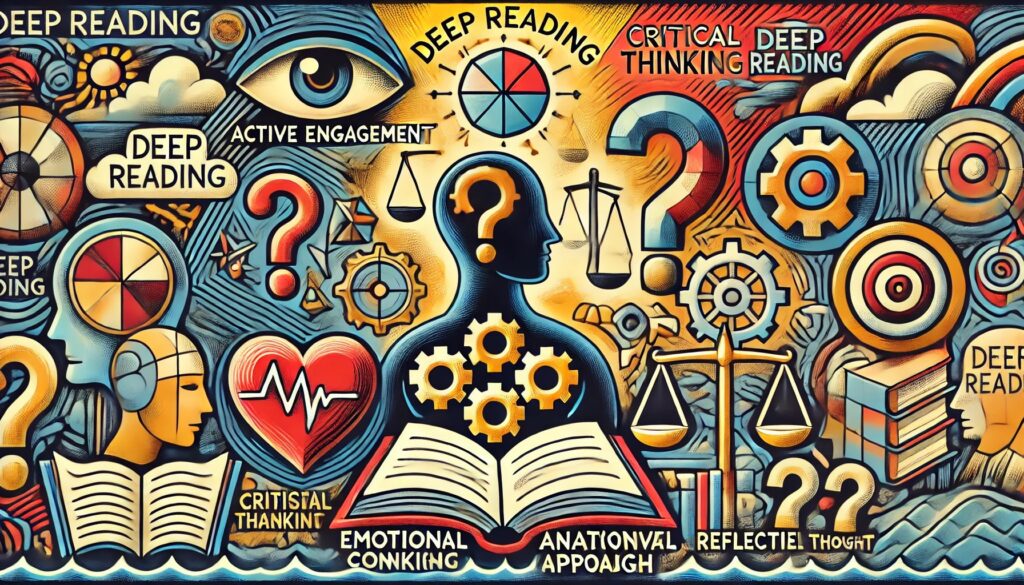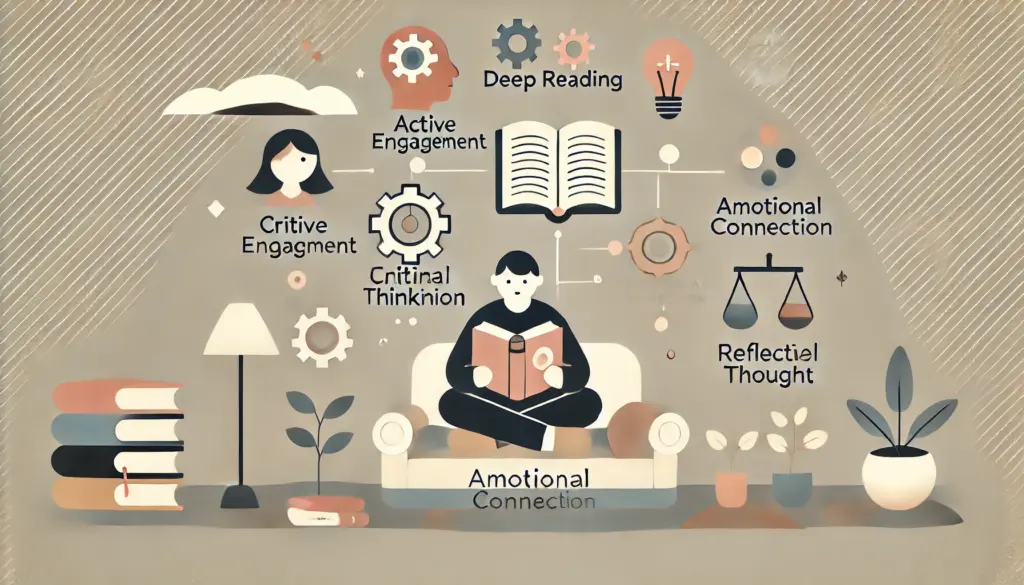
ChatGPT:
Deep reading is a method of reading that involves immersing oneself fully in a text to comprehend its nuances, meanings, and underlying themes. Unlike surface-level reading, which focuses on quickly gathering information, deep reading requires active engagement, critical thinking, and reflection. This process enables readers to make connections, interpret metaphors, and understand the broader context of the material.
Key Characteristics of Deep Reading:
- Active Engagement: Readers interact with the text by asking questions, making predictions, and drawing inferences.
- Critical Thinking: Evaluating arguments, assessing the validity of information, and considering different perspectives.
- Emotional Connection: Empathizing with characters or situations, which enhances understanding and retention.
- Analytical Approach: Breaking down complex ideas into understandable parts and examining the relationships between them.
- Reflective Thought: Considering how the content relates to one’s own experiences or broader societal issues.
Why Is Deep Reading Important?
- Enhances Comprehension: Deep reading leads to a better understanding of complex texts, including literature, academic articles, and philosophical works.
- Improves Critical Thinking Skills: By analyzing and evaluating content, readers develop the ability to think more deeply and critically.
- Boosts Empathy and Emotional Intelligence: Engaging with characters and scenarios fosters empathy and a better understanding of human emotions.
- Strengthens Concentration: The focused nature of deep reading enhances attention span and the ability to concentrate.
Challenges in the Digital Age:
With the rise of digital media, many people engage in skim reading, quickly scanning text for key points. This habit can hinder the ability to read deeply because:
- Information Overload: The vast amount of online content encourages quick consumption rather than thoughtful reflection.
- Distractions: Notifications and hyperlinks can interrupt the reading flow, reducing comprehension.
- Reduced Attention Span: Constant multitasking and switching between tasks make sustained focus more difficult.
Strategies to Practice Deep Reading:
- Choose the Right Environment: Find a quiet, comfortable space free from distractions.
- Set Aside Dedicated Time: Allocate specific periods for reading without interruptions.
- Annotate the Text: Highlight important passages, write notes in the margins, or keep a reading journal.
- Ask Questions: Consider why the author made certain choices or how the text relates to other works.
- Discuss with Others: Sharing insights with peers can deepen understanding and reveal new perspectives.
- Reflect After Reading: Take time to ponder the material’s implications and how it affects your views.
Conclusion:
Deep reading is a valuable skill that enriches the reading experience and promotes intellectual growth. By fully engaging with texts, readers can enhance their comprehension, critical thinking, and empathy. In an era dominated by rapid information consumption, cultivating the habit of deep reading can lead to more meaningful and fulfilling interactions with written works.
From a neuroscience perspective, deep reading can contribute to improving cognitive reserve.
Understanding Cognitive Reserve
Cognitive reserve refers to the brain’s ability to improvise and find alternative ways of getting a job done. It helps individuals maintain cognitive function despite aging or brain pathology, such as Alzheimer’s disease or other forms of dementia. Cognitive reserve is thought to be built up over a lifetime of education and mentally stimulating experiences, which enhance the brain’s networks and efficiency.
Deep Reading and Brain Engagement
Deep reading is a complex cognitive process that goes beyond merely decoding words. It involves:
- Attention and Concentration: Sustained focus activates the prefrontal cortex, improving executive functions.
- Critical Thinking: Analyzing and synthesizing information engages the frontal and parietal lobes.
- Empathy and Theory of Mind: Understanding characters and narratives stimulates the temporal lobe and associated neural networks responsible for social cognition.
- Memory Formation: Retaining and recalling information activates the hippocampus, strengthening memory pathways.
By engaging these multiple brain regions and networks, deep reading acts as a form of cognitive exercise that can enhance neural plasticity—the brain’s ability to reorganize itself by forming new neural connections.
Neuroscientific Evidence
- Increased Neural Connectivity: Studies using functional MRI scans have shown that reading complex texts increases connectivity in the brain, not only during the activity but also for days afterward. This suggests lasting benefits to neural networks.
- Enhanced Language Processing: Deep reading improves the brain’s ability to process language, involving areas like Broca’s and Wernicke’s areas, which are crucial for speech and comprehension.
- Delayed Cognitive Decline: Research has indicated that individuals who engage in regular deep reading and other intellectually stimulating activities tend to experience a slower rate of cognitive decline in old age.
Mechanisms Behind Cognitive Reserve Enhancement
- Neural Efficiency: Deep reading can make neural networks more efficient, allowing the brain to perform tasks with less effort.
- Synaptic Density: Engaging deeply with texts can increase synaptic connections, enhancing communication between neurons.
- Compensatory Mechanisms: A richer cognitive reserve allows the brain to compensate for age-related changes or damage by utilizing alternative neural pathways.
Complementary Activities
While deep reading is beneficial, combining it with other activities can further enhance cognitive reserve:
- Lifelong Learning: Continuous education keeps the brain engaged.
- Physical Exercise: Promotes blood flow to the brain and supports neurogenesis.
- Social Interaction: Stimulates cognitive functions related to communication and emotional regulation.
- Mindfulness and Meditation: Improve attention and reduce stress, which can adversely affect cognitive function.
Conclusion
From a neuroscience perspective, deep reading is more than a leisurely activity; it is a complex cognitive exercise that engages multiple brain regions and processes. By stimulating neural plasticity and enhancing neural networks, deep reading contributes to building and maintaining cognitive reserve. This, in turn, can improve the brain’s resilience against aging and neurological diseases, helping to preserve cognitive function over time.
References:
Small, G. W., Moody, T. D., Siddarth, P., & Bookheimer, S. Y. (2009). Your brain on Google: Patterns of cerebral activation during internet searching. The American Journal of Geriatric Psychiatry, 17(2), 116-126.
Stern, Y. (2012). Cognitive reserve in ageing and Alzheimer’s disease. The Lancet Neurology, 11(11), 1006-1012.
Berns, G. S., Blaine, K., Prietula, M. J., & Pye, B. E. (2013). Short- and long-term effects of a novel on connectivity in the brain. Brain Connectivity, 3(6), 590-600.

